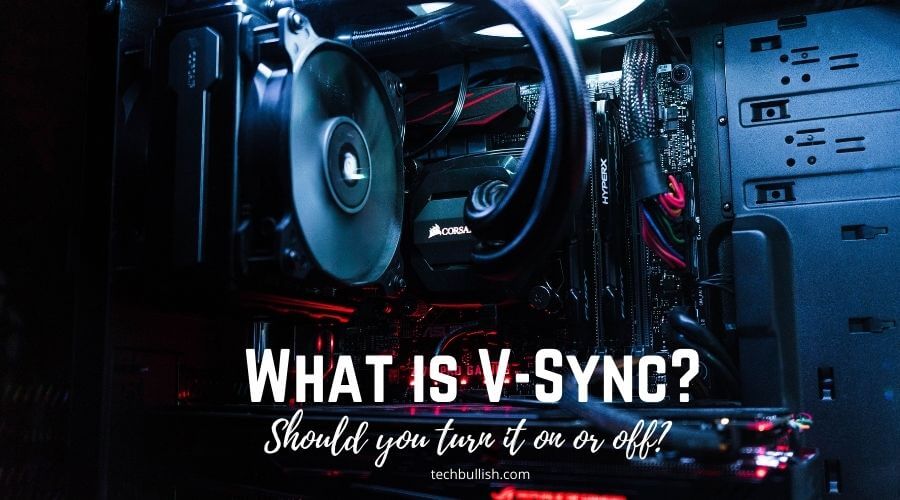If you are a gamer, you would know that the gaming experience relies on the CPU processing, the GPU processing of graphics, and the Monitor that renders your gameplay.
If your graphics card is of high end and supports gaming at 144Hz, and if your Monitor supports only 60Hz, you will notice tearing and stuttering during gameplay.
Tearing and stuttering are not due to your graphics card.
It is happening due to the synchronization problem between your monitor and the graphics card.
The VSync technology came into the picture to solve the screen tearing and provide a good experience in-game.
What is VSync?
V Sync is also known as Vertical Sync. This technology for monitors was devised because the GPU was going at higher frame rates. In contrast, the monitors were limited to a lower framerate.

The VSync technology solves the problem by lowering the Frame rate delivered by the Graphics card to match with the monitor.
VSync helps to solve the Frame synchronization issue that results in tearing during gaming.
In this video, find in detail about the VSync in games from Gaming Scan.
Advanced form of VSync
What is Adaptive VSync?
This is a significant enhancement or improvement from Nvidia that solves the input lag issues.
The Adaptive VSync looks into the monitor’s refresh rate.
Then it monitors if the GPU providing the refresh rate during the game is greater than the monitor refresh rate or not.
If your monitor refresh rate matches the gaming refresh rate, then the VSync would remain off.
When the GPU’s refresh rate during the game exceeds the monitor refresh rate, it will turn on the VSync on the monitor.
It turns off the VSync during the lower refresh rate games.
It prevents Vsync from causing the input lag, which we commonly see when playing at a higher refresh rate with VSync on.
What is Fast Sync?
The following enhancement to the Adaptive VSync is the Fast Sync, and Nvidia did it.
When the game refresh rate is high, and the monitor refresh rate is lower than the VSync would buffer the extra frames provided by the GPU and wait for the monitor to render.
VSync causes input lag till the time the frames are buffering and waiting to get rendered. In Fast Sync, NVidia modified the buffering to triple buffering and picked the best frame data.
So, decrease the lag thrice as compared to the Adaptive sync.
What is Enhanced Sync?
Now AMD has enhanced the Fast Sync even further, and you can use it only if you have AMD Radeon Graphics cards to play games.
With the enhanced V Sync, the VSync technology turns off in case of any performance drop and hence is very much consistent during gaming.
What is Smooth VSync?
Smooth VSync only works when the SLI is enabled.
SLI is also known as Scalable Link Interface and refers to the parallel processing technology by Nvidia.
The SLI uses more than one graphics card to increase the processing power of the GPU.
With smooth VSync, you can crank your monitor to render extremely high FPS games and enjoy playing them.
Smooth VSync is a superior technology and performs well.
The smooth VSync improves the original VSync by locking the sustainable frame rate and can be rendered by the monitor.
This version of VSync gives a smoother experience and helps to remove the stutters as sudden FPS changes do not happen.
What are the benefits of VSync?
- Creates a more fluid gaming experience on monitors that refresh at 60Hz or less.
- The VSync prevents screen tearing when you are playing games. This will be a significant improvement if you have not experienced it before and want to eliminate any such problems from your system. If there is no tear in the monitor during gaming, this would also make for an excellent viewing experience like never before. Every frame delivered from the Graphics card would be on time and delivered without any delay.
- VSync reduces strain on the GPU by lowering its frame rates during the gameplay. The VSync would lower the frame rates according to the monitor’s refresh rate.
- VSync is in-built into the GPU. So, it comes at no additional cost to you. So, it reduces the cost of buying an expensive monitor setup.
What are the cons of VSync?
- It can introduce input lag, due to which your computer waits for the next refresh before displaying new frames. Input Lag is a negative point as it may cause a delay in response time and also could lead to mouse cursor stuttering or feeling delayed.
- It can also result in performance loss as it limits your game’s framerate to the monitor’s refresh rate. VSync will result in lower frame rates and could eventually lead to a drop in FPS.
Should you turn VSync On or Off?
Though the VSync technology solves tearing and stuttering, it is not always wiser to turn it on.
We need to know when we should turn it on or off to get the best performance from your Graphics card and the overall gaming experience.
In this video, check the GTA V played with VSync on and VSync off side by side.
When to Turn VSync Off?
You can turn off the VSync in the following criteria:
- If your monitor’s refresh rate is higher than the game’s refresh rate, you can turn off the VSync.
- You can turn off the VSync when you can control the game FPS in-game settings directly to match your monitor’s refresh rate.
When to Turn VSync On?
You can turn on the VSync in the following criteria:
- You can turn on the VSync if your game is fast-paced and cannot be played, lowering the FPS settings.
- During gameplay, if it goes to high graphic scenes and your performance can suddenly drop. In that case, only VSync can help. Turning on the VSync can help in this case.
Alternatives to VSync
There are several excellent alternatives to the VSync technology:
G-Sync
G-Sync is a technology by Nvidia that solves screen tearing, stuttering, and input lags.
The G-Sync technology only works on the G-Sync enabled to monitor and the Nvidia GeForce graphics cards.
The G-Sync has evolved very much and is very much stable for competitive gaming.
You can learn more about what is G-Sync here.
FreeSync
FreeSync technology from AMD also solves screen tearing, stuttering, and input lag quite well.
You need a FreeSync-enabled monitor and an AMD Radeon Graphics card.
Conclusion
Let’s conclude! As per my gaming experience with VSync, this technology is excellent and useful for general gamers.
If you want to solve the stuttering, tearing, and input lag, you can look into G-Sync or FreeSync.

I’m Anirban Saha, Founder & Editor of TechBullish. With a B.Tech in Electronics and Communication Engineering, and 6+ years of experience as a software developer, I have expertise in electronics, software development, gadgets, and computer peripherals. I love sharing my knowledge through informational articles, how-to guides, and troubleshooting tips for Peripherals, Smart TVs, Streaming Solutions, and more here. Check Anirban’s Crunchbase Profile here.
